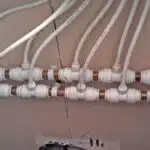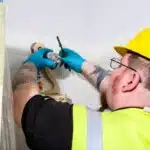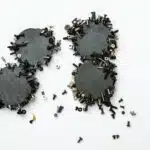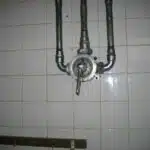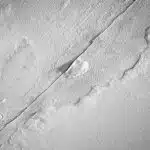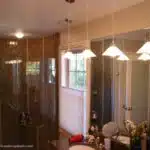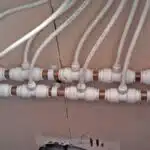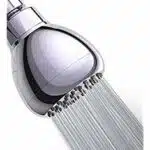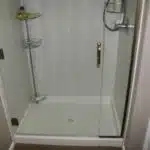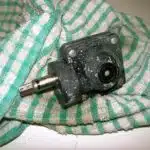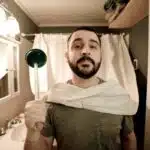As a plumbing expert, it is important to understand the intricacies of installing a shower drain. A properly installed drain ensures efficient and effective drainage, preventing water damage and mold growth in the bathroom. The installation process demands attention to detail and adherence to specific guidelines to ensure that the shower functions optimally.
Installing a shower drain involves several steps, including cutting through the floor or subfloor, installing the drainage pipe, positioning the drain base, attaching the strainer cover, and testing for leaks. While this may seem like an overwhelming task for some homeowners, with proper guidance and instructions, anyone can successfully install a shower drain. In this article, we will provide step-by-step instructions on how to install a shower drain while highlighting important considerations that should be made during the installation process. By following these guidelines, you can ensure that your new shower functions optimally while providing a safe and enjoyable bathing experience for yourself and your loved ones.
Understanding The Importance Of Proper Shower Drain Installation
Proper installation of a shower drain is critical to avoid leaks and water damage. The slope of the shower floor towards the drain is essential for efficient draining. Without a proper slope, water will accumulate in low areas, leading to potential mold and mildew growth. It’s imperative to ensure that the slope is sufficient for the water to flow freely towards the drain.
Choosing the right size of the drain is also crucial for proper installation. Typically, shower drains come in two sizes: 2 inches and 3 inches. The larger size option is suitable for showers with larger tiles or those that have multiple showerheads. In contrast, smaller drains are suitable for single-head showers and smaller tile sizes. Selecting the right size ensures that water can flow effortlessly without backing up.
The importance of slope and choosing the right drain size cannot be overstated when installing a shower drain. Neglecting these aspects can lead to significant problems down the line, such as clogs, leaks, or even structural damage to your home’s foundation. Therefore, it’s essential to keep these considerations in mind during installation and follow best practices. In doing so, you can ensure an effective drainage system that functions optimally while preventing future issues from occurring. With this in mind, let’s now move on to gathering all necessary tools and materials required for a successful installation process.
Gathering The Necessary Tools And Materials
Are you ready to tackle the task of installing a shower drain? Congratulations! You have taken the first step towards becoming a DIY plumbing expert. As with any DIY project, it is important to gather all the necessary tools and materials before starting.
Choosing appropriate materials is crucial for ensuring that your shower drain installation is successful. Make sure to select a drain that fits the size of your shower base, and choose a material that is durable and long-lasting. PVC and ABS are popular choices for their resistance to chemical corrosion, while brass and stainless steel offer greater durability.
Tips for DIY installation include measuring twice before cutting any pipes or fittings, using Teflon tape or pipe joint compound on all threaded connections to prevent leaks, and taking breaks as needed to avoid fatigue or mistakes. Additionally, make sure to follow manufacturer instructions carefully and refer to online tutorials or guides if needed.
In summary, gathering the necessary tools and materials is an essential step in successfully installing a shower drain. Remember to choose appropriate materials such as PVC or brass, measure twice before cutting any pipes, and take breaks as needed during the installation process. Next up, preparing the installation site for your new shower drain!
Preparing The Installation Site
Site preparation is a crucial step when installing a shower drain. Before installation, ensure that the location of the drain is in the right place and that it aligns with the shower base. Then, remove any debris or excess materials from the area to create a clean surface for waterproofing.
It’s also essential to use proper waterproofing techniques to prevent water from seeping through the subfloor or walls. One effective method is using a waterproof membrane, which acts as a barrier between the shower floor and subfloor. Another technique is applying sealant around the edges of the drain to keep water from leaking through.
By taking these measures during site preparation, you can avoid issues such as water damage and mold growth. It’s important to remember that proper site preparation is key to ensuring a successful shower drain installation. In the next section, we will discuss how to assess your plumbing system before beginning installation.
Transition: Now that we’ve covered the importance of site preparation and waterproofing techniques, let’s move on to assessing your plumbing system before starting the installation process.
Assessing The Plumbing System
Upon assessing the plumbing system, it is essential to evaluate the accessibility of the shower drain. A shower drain that is hard to access can lead to difficulties during installation and maintenance. It is crucial to ensure that there is enough space for the plumber to work comfortably around the drain. In addition, it is important to evaluate if there are any obstacles such as pipes and wires that may interfere with the installation of the shower drain.
Another aspect to consider when assessing the plumbing system is checking for obstructions. Before installing a shower drain, it is necessary to inspect if there are any blockages in the pipe or sewer line. Any obstructions can cause water backup, leading to a malfunctioning drainage system. If there are any clogs, they need to be cleared before installing the new shower drain. Failure to do so can result in further complications like leaks and unpleasant odors.
Overall, evaluating accessibility and checking for obstructions in the plumbing system are crucial steps when installing a shower drain. A well-planned installation will save time and money while ensuring a functioning drainage system. The next step involves measuring and cutting a hole for the drain, which requires careful attention and precision.
Measuring And Cutting The Hole For The Drain
After assessing the plumbing system, the next step in installing a shower drain is measuring and cutting the hole for the drain. Cutting techniques vary depending on the material of the shower base, but it is important to use a saw or drill appropriate for that material. When measuring, take into consideration any obstructions such as pipes or studs.
Once you have determined where to cut the hole, you must select an appropriate size. The standard size for a shower drain is 2 inches in diameter, but there are other options available such as 3 or 4 inches. It is important to choose a size that will adequately accommodate water flow without being too large and compromising structural integrity.
Keep in mind that accurately measuring and cutting the hole for the drain is crucial for proper installation. Any mistakes can result in leaks and costly repairs down the line. With this step completed, you can move on to installing the drainage pipe which will connect to your home’s plumbing system.
Installing The Drainage Pipe
When it comes to installing a shower drain, one of the most crucial steps is installing the drainage pipe. The drainage pipe is responsible for carrying water away from the shower and into the sewer system or septic tank. Proper installation of the drainage pipe will ensure that your shower functions efficiently and doesn’t cause any water damage to your home.
To install the drainage pipe, you will need to first determine where it needs to be positioned. This will depend on factors such as the location of your shower and the slope of your floor. Once you have determined where you want to position the drain, you can begin cutting and fitting the PVC piping. It is important to use proper techniques when cutting and fitting pipes to ensure a secure fit.
Tips for installing a drainage pipe include using a level to ensure that it is installed at the correct angle for proper water flow. Additionally, make sure that all connections are tight and secure to prevent leaks. It may also be helpful to use Teflon tape or pipe thread sealant on connections for added security.
Next, we will move on to positioning the drain base, which is another critical step in installing a shower drain. By following these tips and techniques for installing a drainage pipe, you can ensure that your shower functions properly while minimizing any potential issues down the line.
Positioning The Drain Base
As we move onto the next step of installing a shower drain, it’s crucial to position the drain base correctly. This involves determining the slope of your shower floor as well as ensuring that the waterproofing membrane is installed properly.
The shower drain slope is an essential factor in preventing water from pooling in your bathroom. To determine the correct slope, use a level and measure from the highest point of your shower floor to where you want the drain to be located. The recommended slope for a shower floor is ¼ inch per foot. This ensures that water flows towards the drain and prevents stagnant water from accumulating.
Before installing the drain base, make sure that your waterproofing membrane is in place. This will help protect your subfloor from moisture damage and prevent water from seeping into other areas of your home. Proper installation of a waterproofing membrane is critical to ensure long-lasting results and prevent costly repairs down the road. Once you have ensured that both these steps are complete, you can move on to connecting the drain to the plumbing system.
Connecting The Drain To The Plumbing System
- In order to connect a shower drain to the plumbing system, cutting and joining pipes is necessary.
- The first step is to measure and cut a length of pipe that will fit from the drain to the waste pipe.
- Once the pipe is cut, the next step is to join it to the waste pipe using a solvent weld or compression fitting.
- Finally, the drain can be attached to the other end of the pipe and secured in place with a rubber seal and screws.
Cutting And Joining Pipes
Cutting and joining pipes is an essential step in installing a shower drain. It requires the use of pipe cutting techniques to ensure precise cuts for a proper fit. The most common pipe cutting methods are with a hacksaw or a reciprocating saw. A hacksaw can be used for small cuts, while a reciprocating saw is ideal for cutting larger pipes. It is crucial to measure the length of the pipes accurately before cutting them to prevent any wastage.
Joining methods for plumbing vary depending on the material of the pipes. For PVC pipes, solvent welding or gluing is commonly used to join them together. This involves applying PVC primer and cement to both ends of the pipe, inserting them into each other, and holding them in place until they bond. For copper pipes, soldering or brazing is typically used to join them together. This method involves heating the joint with a torch and applying solder or brazing filler metal until it melts and fuses with the adjacent metal.
To ensure that there are no leaks in your shower drain system, it’s vital that you use proper pipe cutting and joining methods when connecting the drain to the plumbing system. Always wear protective gear when using tools such as saws or torches and follow manufacturer instructions closely. With these tips in mind, you’ll be able to install your shower drain with confidence and enjoy a leak-free plumbing system that lasts for years without any issues.
Connecting Drain To Waste Pipe
Connecting the drain to the plumbing system is a crucial step in installing a shower, and it requires careful attention to detail. Proper pipe alignment is essential when connecting the drain to the waste pipe to prevent leaks. One of the critical factors in ensuring proper alignment is measuring and cutting the pipes accurately. This ensures that there are no gaps between pipes or misalignments, which can cause water leakage.
When connecting the drain to the waste pipe, it’s vital to use leak prevention techniques. Leaks can cause significant damage and result in costly repairs. To prevent leaks, plumbers often use sealants such as Teflon tape or pipe dope on threaded connections. For slip-joint connections, plumbers may use rubber gaskets or silicone sealant. These techniques create a tight seal between pipes that prevents water from leaking out.
In summary, connecting the drain to the plumbing system requires proper pipe alignment and leak prevention techniques. Plumbers must measure and cut pipes accurately while using appropriate methods for joining them together. Additionally, plumbers must ensure that all connections are sealed correctly with Teflon tape, pipe dope, rubber gaskets or silicone sealant to prevent leaks from occurring. By following these steps carefully, homeowners can avoid costly repairs and enjoy a properly functioning shower for years to come.
Installing The Strainer Cover
Next, it is important to take note of the cleaning instructions for your shower drain. It is recommended to clean the drain at least once a month to prevent any blockages or build-up of debris. The best way to do this is by removing the strainer cover and using a drain brush or a mixture of baking soda and vinegar to clean the inside of the drain.
When it comes to installing the strainer cover, there are now decorative options available in addition to the standard metal covers. These options include covers with designs such as seashells or flowers, which can add an extra touch of personality to your shower. However, it is important to ensure that any decorative cover you choose still allows for proper drainage.
Finally, before sealing the drain, double-check that all connections are tightly secured and leak-free. It is crucial that no water leaks through any gaps in your plumbing system as this can cause damage over time. Once everything is secure, you can proceed with sealing the drain according to manufacturer instructions. This will help ensure that your shower remains leak-free and functional for years to come.
Sealing The Drain
Once the shower drain has been installed, it is essential to ensure that it is properly sealed to prevent water from seeping through and causing damage. Waterproofing techniques are necessary to keep water from penetrating the surrounding areas of the shower. There are different types of drain seals, including silicone caulk or PVC cement, which can be used to seal the edges of the drain.
Silicone caulk is a popular choice for sealing shower drains due to its flexibility and ease of use. It is applied using a caulking gun and can be smoothed out with a tool or finger. The silicone will adhere to both the drain body and surrounding surfaces, creating a waterproof seal that will last for years.
PVC cement is another option for sealing shower drains, particularly those made of PVC material. The cement is applied using a brush and creates a permanent bond between the drain body and surrounding pipes. Once dried, it creates a strong seal that will not break down with exposure to water or other elements. Using either silicone caulk or PVC cement ensures that your newly installed shower drain remains watertight and leak-free.
To ensure that your shower drain is properly sealed, testing for leaks should be done before completing any additional work on the bathroom. This step involves filling the shower basin with water and allowing it to sit for several hours while monitoring for any signs of leakage around the drain area. If any leaks are detected, adjustments can then be made before moving on to finishing touches such as tiling or painting.
Testing For Leaks
Testing for leaks should begin with a thorough inspection of the shower drain. Water must be used to test for leaks; this is done by filling the shower with several inches of water and then observing for any signs of water escaping around the drain. Vibration should also be checked for; this can be done by placing a hand on the drainpipe while running the shower to ensure no excessive vibrations are present. Lastly, the drainpipe should be inspected for any signs of corrosion or damage, as this could be a source of leaks.
Testing With Water
As a plumbing expert, you know that one of the most important steps in installing a shower drain is testing for leaks. And when it comes to testing for leaks, there’s no better way than using water. However, before you start pouring water down the drain, it’s essential to be aware of common problems and troubleshooting techniques.
One common problem during testing with water is leaks around the drain flange. This can happen if the flange isn’t installed correctly or if there are gaps between the flange and the shower base. To troubleshoot this issue, inspect the flange and make sure it’s secured tightly to the base. If there are gaps, use caulking to seal them.
Another problem that may arise during testing with water is slow drainage or blockages. This could be due to debris getting caught in the drain or improper installation of the drain assembly. Troubleshooting this problem involves checking for any clogs and ensuring that all components of the drain assembly are properly aligned.
In conclusion, testing with water is a crucial step in installing a shower drain. As a plumbing expert, being aware of common problems and troubleshooting techniques will ensure that your installation process goes smoothly and without any issues. By taking these necessary precautions, you’ll be able to provide exceptional service to your customers and leave them satisfied with their newly installed shower drain.
Checking For Vibration
As a plumbing expert, you are aware that testing for leaks is an integral part of installing a shower drain. However, it is not just about checking for leaks; there are other issues to address as well. Vibration and noise during the use of the shower can be a problem, and it is crucial to prevent them from happening.
One potential issue with shower drains is vibration. When water flows through the drain, it can create vibrations that transfer to the surrounding area, causing noise and discomfort. To prevent this, it’s essential to ensure that the drain assembly is secure and tightly fitted into place. Any loose connections or fittings should be tightened to prevent vibration.
Addressing noise during shower use is also important when testing for leaks. If there are any gaps or spaces between the drain assembly and the shower base or walls, water flow can create noise as it passes through these openings. Therefore, it’s essential to check for any gaps or spaces and seal them properly using caulking or sealant. By taking these precautions when testing for leaks, you can provide your customers with a quieter and more comfortable shower experience.
Overall, when testing for leaks during shower drain installation, preventing vibration and addressing noise should be considered alongside checking for leaks themselves. As a plumbing expert, ensuring that all components of the drain assembly are correctly installed will help prevent any unwanted noises or vibrations during use. By doing so, you can provide exceptional service to your customers by leaving them satisfied with their newly installed shower drain that functions quietly and efficiently.
Inspecting The Drainpipe
As a plumbing expert, ensuring that the shower drain installation is leak-free is crucial. In addition to preventing leaks, inspecting the drainpipe is also necessary. Checking clearance and assessing slope are two essential aspects of inspecting the drainpipe during testing for leaks.
Clearance refers to the amount of space between the drainpipe and surrounding components such as walls or flooring. It’s crucial to check if there’s enough space for water to flow freely through the pipe without any obstructions. If there’s not enough clearance, water can back up and cause leaks or other problems. Therefore, it’s essential to ensure that there is adequate clearance when installing a shower drain.
Assessing slope involves checking if the drainpipe has an appropriate angle for water to flow effectively towards it. A properly sloped drainpipe will allow water to move quickly and smoothly toward the main sewer line without any blockages or backups. On the other hand, if there’s no slope or insufficient slope in the drainpipe, water can accumulate and cause clogs or leaks that can damage your customer’s property over time. Therefore, it’s essential to assess slope during testing for leaks while installing a shower drain to prevent these issues from occurring in the future.
Making Adjustments As Needed
Adjustment techniques are an essential part of installing a shower drain. In most cases, the installation process is not a perfect fit and requires some adjustments to get it right. One of the most common mistakes that people make during the installation process is failing to account for these adjustments, leading to leaks and other issues.
One technique that can help you make necessary adjustments is dry fitting all the parts before gluing or tightening anything in place. By doing this, you can identify any areas where adjustment is needed and make those changes accordingly. Another technique is checking for leaks after each step of the installation process. This will allow you to catch any issues early on and adjust as necessary.
Common mistakes during the adjustment process include over-tightening fittings, which can cause damage to pipes or fittings, or under-tightening them, which can lead to leaks. It is also important to ensure that all parts are properly aligned before tightening them in place. Failure to do so can cause stress on joint connections and result in leaks.
As you continue with your shower drain installation project, it’s essential to keep in mind these adjustment techniques and avoid common mistakes. By doing so, you’ll be able to achieve a successful installation with minimal issues down the line. Next up, we’ll discuss how to clean up the installation site after completing the project.
Cleaning Up The Installation Site
After successfully installing the shower drain, it is important to clean up the installation site to ensure that there are no leftover materials or debris that could potentially cause harm. Choosing materials that are easy to clean and dispose of can make this task easier. When purchasing materials for the installation process, consider ones that can be easily wiped down with a damp cloth or vacuumed up without leaving any residue behind.
Proper disposal of any excess materials is also crucial in maintaining a clean installation site. This involves disposing of any unused parts, packaging, or excess material in an appropriate manner. It is important to follow local regulations for waste disposal and not simply throw everything away in the trash. In addition, it is recommended to keep the area around the installation site free from clutter and debris to prevent accidents.
By taking these steps to clean up after installing a shower drain, you can help ensure that your bathroom remains safe and functional. In addition, maintaining a clean installation site can also help prolong the lifespan of your shower drain by preventing clogs and other issues from developing. To continue proper maintenance of your shower drain, there are additional steps you can take such as regularly cleaning it and checking for leaks.
Maintaining Your Shower Drain
- Cleaning the shower drain should be done regularly in order to prevent clogs and leaks, especially if the shower is used often.
- To clean the shower drain, use a plunger to push debris and dirt out of the drain.
- Clogs in the shower drain should be addressed immediately, as they can cause water to back up and create unwanted messes.
- To address clogs, first try using a drain snake to remove the blockage.
- If the clog persists, a chemical cleaner may be necessary to clear it.
- After cleaning the drain and addressing any clogs, check for leaks to ensure that the shower drain is properly maintained.
Cleaning The Drain
Keeping your shower drain clean is crucial to prevent clogs and maintain a fully functioning plumbing system. To properly clean your shower drain, you will need some essential cleaning tools such as a plunger, a drain snake, and a pair of gloves. These tools will help you remove any hair, soap scum or other debris that may be causing blockages in your pipes.
Preventing clogs starts with regular cleaning of your shower drain. You should aim to clean it at least once a week to avoid buildup of dirt and grime that may lead to blockages. When using a plunger, apply firm pressure while ensuring that the rubber cup creates an air-tight seal over the drain hole. A drain snake can also be used for more thorough cleaning by inserting it into the drain and twisting it around to dislodge any blockages.
In conclusion, keeping your shower drain clean is essential for preventing clogs and maintaining a healthy plumbing system. By using the right cleaning tools such as a plunger or a drain snake, you can easily remove any debris that may be causing blockages in your pipes. Incorporating regular cleaning into your maintenance routine will ensure that your shower drains function efficiently for years to come.
Addressing Clogs
Now that we have discussed the importance of keeping your shower drain clean, let us move on to addressing clogs. Common clog causes in shower drains include hair, soap scum, and mineral buildup. These materials can accumulate in the pipes over time, leading to blockages that prevent water from draining properly. If left unaddressed, these clogs can cause serious plumbing problems that require costly repairs.
To prevent clogs from forming in your shower drain, it is important to take preventive measures. First, install a drain cover or strainer to catch hair and other debris before they enter the pipes. Second, avoid pouring grease or oil down the drain as they can solidify and cause blockages. Finally, consider using a natural enzyme cleaner once a month to break down any buildup in the pipes.
If you do experience a clog in your shower drain despite taking preventive measures, do not panic! Avoid using chemical drain cleaners as they can corrode your pipes and cause further damage. Instead, try using a plunger or a drain snake to remove the blockage manually. If these methods do not work, it may be time to call in a professional plumber who has specialized tools and expertise to handle more serious clogs.
Checking For Leaks
Now that we have discussed the importance of preventing clogs in your shower drain, let us move on to another crucial aspect of maintaining your plumbing system: checking for leaks. Common leaks in shower systems can occur around the faucet, handles, and pipes. These leaks can lead to water damage, mold growth, and increased water bills if left unaddressed.
To prevent common leaks from forming in your shower system, it is important to take preventive measures. First, check regularly for any signs of moisture or discoloration around the faucet and handles. Second, inspect the pipes for any cracks or rust spots that may indicate a leak. Finally, consider installing a pressure regulator to maintain consistent water pressure and prevent stress on the pipes.
If you do notice a leak in your shower system despite taking preventive measures, it is important to address it promptly. Even small leaks can cause significant damage over time if left unattended. To diagnose the source of the leak, turn off the water supply to the shower and inspect each component for visible damage or wear. If you are unable to identify the source of the leak or you require repairs beyond your scope of expertise, it may be time to call in a professional plumber who has specialized tools and expertise to handle more serious leaks.
Remember that maintaining your shower drain and plumbing system requires regular attention and preventative care. By following these prevention tips and promptly addressing any issues that arise, you can ensure a safe and efficient plumbing system for years to come.
Troubleshooting Common Issues With Shower Drains
Maintaining your shower drain is essential to ensure a clean and hygienic bathroom experience. However, even with proper maintenance, issues may arise with your shower drain that require troubleshooting. One common problem that homeowners encounter is clogs in the drain or slow water drainage. This can be caused by a buildup of hair, soap scum, or other debris.
To troubleshoot clogs in your shower drain, start by using a plunger to dislodge any blockages. If this method does not work, try using a plumbing snake to break up the clog and remove it from the drain. Another option is to use a mixture of baking soda and vinegar to dissolve the blockage naturally.
Preventing future issues with your shower drain can save you time and money in the long run. One way to do this is by installing a hair catcher over the drain to prevent hair and other debris from entering the pipes. Regularly cleaning the drain with hot water and vinegar can also help prevent buildup and clogs from forming. Additionally, avoid pouring grease or oil down the drain as this can solidify and cause blockages.
By following these tips for troubleshooting common issues with your shower drain and preventing future problems, you can ensure a functioning and clean bathroom for years to come. As a plumbing expert, it’s important to educate homeowners on proper maintenance techniques that will keep their plumbing systems running smoothly without costly repairs or replacements needed down the line.
Conclusion
Proper installation of a shower drain is crucial to ensure the efficient flow of water and prevent any potential damage to your bathroom. The process may seem daunting, but with the right tools and materials, it can be done easily. Understanding the importance of proper installation, assessing your plumbing system, measuring and cutting the hole for the drain are just a few steps involved.
Once installed, it is important to maintain your shower drain regularly to avoid any clogging or leakage issues. Troubleshooting common problems such as slow drainage or unpleasant odors will help you keep your shower functioning smoothly. As a plumbing expert, I highly recommend taking the time to follow these steps carefully and ensuring that you have all necessary tools and materials before commencing installation. With proper installation and maintenance, your shower drain will remain in good condition for years to come.
Image Credits

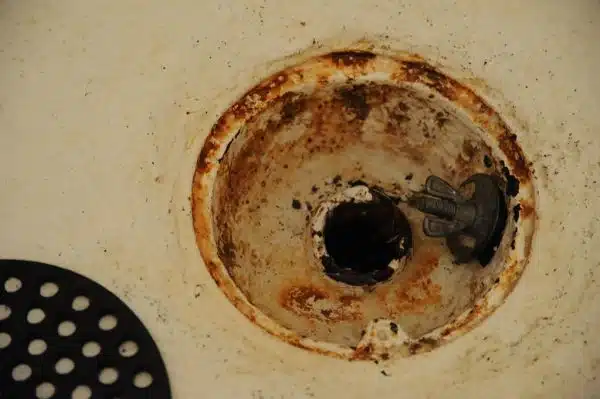



![How To Get Hair Out Of A Bathtub Drain 5 2/365 [Bathtub Drain]](https://green-life.blog/wp-content/uploads/2023/05/cOEu5edpkejq-150x150.jpg.webp)
